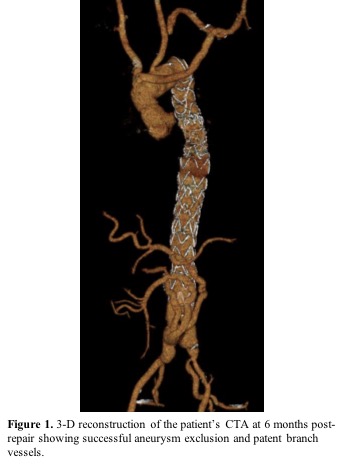Single-stage Hybrid Repair Of A Thoracoabdominal Aortic Aneurysm Complicated By Chronic Type B Aortic Dissection And Kommerell's Diverticulum Via Simultaneous Median Sternotomy And Laparotomy
Dominic LeBlanc, MD, Audra Duncan, MD, Michael Chu, MD.
Western University, London, ON, Canada.
DEMOGRAPHICS: A 54 year-old Caucasian male non-smoker with enlarging 5.7cm thoracoabdominal aortic aneurysm (TAAA) after Type B dissection with concomitant Kommerell diverticulum (KD). HISTORY: The patient presented 1.5 years after attempted staged repair elsewhere that included right carotid-subclavian bypass (complicated by phrenic nerve injury). The staged procedure was abandoned. A left renal artery stent was placed for renovascular hypertension elsewhere. The left kidney was now atrophic and he required 4 antihypertensive medications but had poor blood pressure control. Growth rate of the TAAA was >1.0cm/year. The dissection originated at the KD and visceral vessels were perfused by the true lumen. PLAN: Definitive repair was planned with involvement of Vascular and Cardiac Surgery. Due to his young age and a report of excessive bleeding and fragile vessels during the carotid-subclavian, connective tissue disorder was suspected. Because of his phrenic nerve injury and paralyzed diaphragm, a left cervical or left thoracoabdominal approach was high risk of resulting in bilateral diaphragm compromise. Complete aortic replacement was most appropriate given the aneurysm extent and his young age. The operation involved ascending and aortic arch replacement under hypothermic circulatory arrest with a frozen hybrid elephant trunk (ThoraflexTM) reconstruction, abdominal aortic replacement, debranching of visceral vessels, bridging TEVAR, and left nephrectomy as a single stage procedure via simultaneous median sternotomy and midline laparotomy. The procedure was performed with spinal drain. The abdominal vessels were debranched from the right limb of a prosthetic abdominal aortic graft. The thoracic endograft was delivered via a left iliac conduit to bridge the frozen elephant trunk and abdominal grafts. He had a prolonged ICU stay secondary to transient spinal cord ischemia with paraparesis, renal failure and ischemic colitis. He was discharged home with follow up CT at 14 months showing successful TAAA repair. He is now 28 months post-repair, with borderline elevated creatinine, on a single antihypertensive agent, ambulating normally and back to working his pre-operative job. DISCUSSION: In order to avoid left thoracotomy, simultaneous sternotomy (hybrid frozen elephant trunk) and laparotomy for distal aneurysm repair and visceral debranching, with single-stage bridging TEVAR is a feasible approach.

Back to 2020 Abstracts
